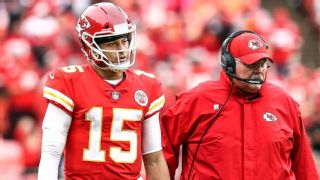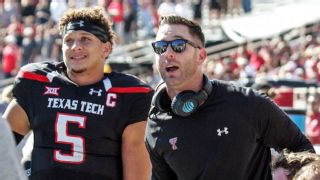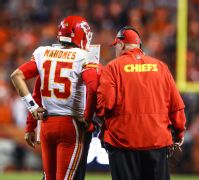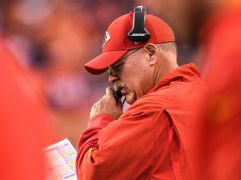|
Andy Reid had seen the arm. Everyone had. You couldn't miss the effortless way Patrick Mahomes flicked the football at Texas Tech, how the ball left his hand at impossible angles, traveling farther and at a higher velocity than anyone else playing college football in 2016. None of that mattered much to Reid. What caught his eye -- the moment he began to consider drafting a quarterback to replace his then-32-year-old Pro Bowl starter -- was how often Mahomes' seemingly wild throws found their targets. Reid has built his two-decade romp through offensive football on a simple foundation: Quarterbacks who were accurate and who had what longtime friend and former Philadelphia Eagles executive Joe Banner calls "mental acumen." The film confirmed Mahomes had the former. Now it was time to find out about the latter. Reid and the Kansas City Chiefs hosted Mahomes for a pre-draft workout during the spring of 2017. Like other teams, they created a mock install day to teach him a portion of their offense. Mahomes sat quietly, listening and writing furiously with a pencil, as Reid taught him a selection of plays, formations, protections and calls. When it was over, they sent him out of the room for a break and to test his retention. When he returned, Reid flipped the scenario. Now it was time for Mahomes to "install" the offense to him. Mahomes walked to the front of the room, stood at the white board and -- in the unique Texas-twang voice that Reid has appropriately called "froggish" -- spit out the Chiefs' offense nearly verbatim from the morning session. "The recall that he has is crazy," offensive coordinator Eric Bieniemy said later. "You can go through maybe 12-15 plays during a seven-on-seven period. Then later, you sit back and ask him exactly what happened on, say, Play 3. He can recall exactly what happened, who he threw it to. He can tell you exactly what coverage they were playing, right off the top of his head. That's one of the most impressive things about him. That tells you he sees everything and absorbs it, what a lot of guys don't." He displayed not only what the Chiefs would discover to be a photographic memory, the kind that Hall of Fame quarterback Kurt Warner has said exists in all elite passers, but also a deep understanding of the connection of NFL concepts. In an interview with The Los Angeles Times, former Arizona Cardinals coach Bruce Arians later compared him to the way Peyton Manning and Drew Brees sound when they talk football. Reid was sold. "You got the sense," Reid said recently in his understated way, "that Patrick was going to be OK." Reid decided Mahomes was a player worth upending a plan to ride out veteran Alex Smith in the final stages of his pursuit of a Super Bowl championship. Reid, the 10th-winningest coach in NFL history with 188 career victories, was ready to take a leap of faith into the future. Mahomes fit perfectly into the hybrid West Coast/spread scheme he had developed. "Alex is phenomenal," Reid said. "I love the guy. He was doing well. But you always want to make sure that the position is covered. Alex isn't getting any younger. He knew it. We knew it."  Unbeknownst to Reid, those who cared about Mahomes were rooting for a similar conclusion. "I selfishly hoped for him that he would go to the Chiefs," Texas Tech coach Kliff Kingsbury said. "Just knowing what Andy Reid does offensively, how he adjusts personnel, and how he's adapted to every quarterback he's had and gotten them playing to a high level. Ideal spot. Just a perfect storm." The story of Mahomes' rise to the early MVP race behind the Chiefs' 5-0 start and his league-leading 86.2 Total QBR is an intersection between two powerhouses that fit together in a way that only happens in football heaven. ReidWorld is where quarterbacks go to flourish. "When you're looking at quarterbacks in the draft, the first question is always, 'Where are they going to go?'" said ESPN analyst Louis Riddick, who worked six years alongside Reid when they were with the Eagles. "And once I know that, I'll be able to get behind what I think the guy is going to turn into. So when Andy drafted Patrick, I was like, 'Done. Done deal.' Because I knew how he was going to be handled."
Mahomes spent his youth around some of the country's top pro athletes. During the summer, he accompanied his father, retired MLB pitcher Pat Mahomes, to big league ballparks. But Patrick didn't stand in awe of the players he encountered. He absorbed, after some initial shock, the work they put in during the hours before a game. Alex Rodriguez, the best hitter in the game, would swat hundreds of balls off a tee. Mahomes' dad, who pitched for six different big league teams from 1992 to 2003, would study his notes on each opposing hitter, over and over, until he memorized them. "No one really sees pro athletes behind the scenes," the quarterback said. "They don't know how hard they work. They don't see how you work on the basics. They couldn't possibly know. You wouldn't think that someone who hits like Alex Rodriguez needs to use a tee every day. But that's how he stayed on top of it. So that's something I got to see at a young age, and something I can apply now." Brad Childress, a Chiefs assistant when Mahomes was drafted and now head coach of the Alliance of American Football's Atlanta Legends, noticed that gravitas right away. "You could tell that he already knew what all the pros eventually learn," Childress said. "They're not great because they're great. They work to be great." More than anything, Mahomes said he understood the NFL workload needed outside of practice and team meetings. When he and his father would return home after a day game, Patrick would play video games or run out to play with his friends. Pat? He would sit down and start studying his hitter notes again. "I use that in my own study habits," Mahomes said. "Take our game plans. Each week, there is some carryover from the previous week. It's the same stuff. But I go over that part, too, every day, just to make sure I know every aspect of it and don't take it for granted. You don't want to get lazy about that, even right before a game, because that can affect how you play."  It was long assumed Mahomes would apply those lessons to baseball. He was a dual-sport star growing up in Whitehouse, Texas, pitching and playing outfield, and he was drafted in the 37th round of the 2014 MLB draft by the Detroit Tigers. But it wasn't until his junior year at Texas Tech that he committed to football over baseball. The binary nature of his sports journey in many ways helped shape the playing style that NFL fans are just waking up to. More than his rocket arm, Mahomes relies on instinctive breaks from the pocket to find open receivers. Mahomes referred to it as "using every inch of green grass on the field, whether horizontally or vertically." Kingsbury attributed it to the unexpected but rewarding consequence of splitting time between baseball and football in his youth. "He just wasn't overcoached," Kingsbury said. "Maybe by not having the quarterback tutors that would have worked on his fundamentals, telling him he always had to step to his target and have his elbow at a certain angle. Maybe that helped him learn to throw the football on his own. He has touch and accuracy from different angles and different platforms. His ball just has a natural way of coming out, and you can see that in the way he plays." This season, Mahomes leads the NFL with 345 passing yards on throws released outside of the pocket, according to NFL Next Gen Stats. In Week 4 against the Denver Broncos, he threw for 192 such yards, more than any NFL quarterback in the past 10 years. In that game, Mahomes wowed the football world by shifting the ball to his left hand while under duress and completing a short pass to Tyreek Hill for a first down. It was the kind of improvisational play that recalled the style of Hall of Fame quarterback Brett Favre, who spent three seasons playing for a quarterbacks coach named Andy Reid. When he saw it, Kingsbury didn't blink. His mind went back to October 2016, in Texas Tech's wild "game that broke college football" against Oklahoma, when Mahomes pulled off a similar stunt to avoid a sack on his way to more than 800 total yards. "Those off-schedule throws are a part of who he is," Kingsbury said. "You see some guys that got repped over and over on certain fundamentals that limit them. He plays with a freeness and throws with a freeness that allows him to do spectacular things. He was never really corralled into a mechanical five-step drop, stay in the pocket, find your check downs. He was always allowed to cut it loose and play. There have been skeptics at every level saying it won't work. But that's what he's really good at." To make it work, however, he needed a coach who would welcome an unorthodox quarterback and was all about challenging convention. As it turned out, Reid had been building toward this moment for more than a decade.
Banner can remember the conversations inside the Eagles' front offices. After appearing in Super Bowl XXXIX after the 2004 season, the Eagles missed the playoffs two of the next three seasons. The game was changing. Reid saw it and was determined to get out in front of the curve. "He started talking about integrating spread college elements into a West Coast pro offense at least 10-12 years ago," Banner said. "You can see it if you go back and look at the tape. Andy is fearless and passionately believes in being aggressive, and I think he recognizes that occasionally being aggressive will blow up in your face. But the benefits massively outweigh the times that it can blow up in your face." The first real test came in 2010, when the Eagles replaced six-time Pro Bowl starter Donovan McNabb with Michael Vick. Reid valued Vick's mobility, even after two idle years spent in jail after pleading guilty to dogfighting charges. More than that, Reid thought Vick was a more accurate passer than most teams realized. As a franchise, Banner said, "We thought Michael Vick could be the guy who could prove that the West Coast offense could integrate spread concepts and revolutionize the NFL." The results of Reid's experiment were mixed. The Eagles went 18-16 in Vick's 34 starts under Reid, making the playoffs once in three injury-plagued seasons. But Vick also completed 60.2 percent of his passes in that time, much higher than his career percentage of 53.9 in all other seasons. Something was there, Reid thought. He was undeterred. After moving to Kansas City in 2013, he acquired veteran quarterback Alex Smith to continue and escalate the journey. Smith went on to have the best five years of his career with Reid. "Every quarterback is different," Reid said, "and your job as a coach is to try to exploit his strengths, work on his weaknesses and then get them better. That's all we ever try to do with our scheme."
In the staid and conventional NFL, it wasn't easy to project that the same man who designed the Eagles' offenses would be responsible for the Chiefs' crazy-town scheme of 2018. With arguably the NFL's fastest receiver in Hill, a tight end in Travis Kelce who can outrun many safeties and a tailback in Kareem Hunt who moves seamlessly between the running and passing games, the Chiefs terrorize opponents with a tornado of horizontal pre- and post-snap movement. They are now what ESPN's Louis Riddick calls "Turbo Andy." "That's really what they are," Riddick said. "Andy has always had this in his head. The game has been moving this way anyway. He's taking what the competition committee is allowing him to have, which is whatever the hell offenses want to have. They can take what they want and he's doing it. He spreads you out, attacks you in multiple different ways, and now -- with all due respect to Alex Smith -- he has a guy now who can just be deadly with it."  Kingsbury sees it, too. "I look at it as a perfect storm in terms of the weapons and coaching," he said. "Andy Reid is allowing him to play to his strengths. He's putting him in empty [backfield formations] and just letting him go and be Patrick." Reid once envisioned Smith as the long-term caretaker of this evolving scheme. But when co-director of player personnel Brett Veach brought him a strong early scouting report of Mahomes, and then-general manager John Dorsey endorsed it, Reid agreed to take a closer look. Dorsey reported directly to owner Clark Hunt, as Veach -- the Chiefs' current general manager -- does now. But everyone in the building knew there was no sense in drafting a quarterback without Reid's approval. His consent was sealed after Mahomes' pre-draft visit. Childress recalled the ease with which Mahomes spit out complicated pro-style playcalls, right down to the pauses that transition from one position group to another. "We always tell our offense to listen to the words that speak to you," Childress said. "They all don't speak to you. Different parts are for different position groups. They get their piece of information. Obviously, it's got to be clear. Everybody's got to hear you, they've got to see you. So if you're wobbling through those things, you don't have much of a chance. He could handle that right away." When the opportunity arrived to take Mahomes, Reid couldn't pass it up. Even with a roster that many NFL observers thought could power a run to the Super Bowl, the Chiefs traded up to the No. 10 overall pick -- giving up the No. 27 pick, their third-round pick, and their 2018 first-round choice to the Buffalo Bills so they could draft Mahomes as the second QB off the board -- ostensibly to sit idle for a year or more.  "Brett was on him a year and a half or two years before and just kept bringing it and bringing it," Reid said. "You want to make sure, whether the guy is there five years as a backup or one year, you just want to make sure that you have one when Alex moves on." The conventional narrative suggests Mahomes, who fully committed to football only two years ago, benefited from his year watching Smith. But the truth is the Chiefs knew what he could do right away from the moment they got him in the door. "I talk to Brett Veach and those guys all the time," Riddick said. "They were telling me from Day 1, Lou, you just don't understand what this guy is doing already." Even Smith saw it and realized Mahomes' time would come quickly. "I think the physical tools aside, which he does have a unique tool set, it's more the processing," said Smith, now the Washington Redskins' starter. "He processes things really well and processes fast. He sees things quick, learns fast. He's not a guy you had to repeat things to. He knew. He saw the game well. I felt it was never too fast for him, even last year."
Mahomes' skill alone does not fully explain this five-game stretch. Neither does the undeniable presence of the Chiefs' weapons, from Hill to Kelce to Hunt to receiver Sammy Watkins. Reid's scheme and playcalling is springing his receivers open in ways unmatched around most of the league. This season, according to NFL Next Gen Stats, 49.5 percent of Mahomes' attempts have gone toward wide-open targets, defined as receivers with three or more yards of separation from the nearest defender. That figure ranks fifth in the NFL. And a scheme that gets receivers open at that rate has helped Mahomes move away from his biggest deficiency in college: interceptions. He threw 25 picks as the Texas Tech starter in 2015 and 2016, the fourth-highest total among FBS schools over that stretch, making mistakes that Kingsbury attributed to his aggressive style. With the Chiefs in 2018, Mahomes has thrown two interceptions in 176 attempts and none until Week 5. That puts him on pace to throw about six over a full season, even though the Chiefs have allowed the NFL's seventh-worst pressure rate (32.8).  "How well you can call plays that put players in great positions is so important for how a quarterback performs," Riddick said. "That's what matters. It's what separates Andy. ... I've been on headsets, especially when we were in Philadelphia, and the clock is ticking down and you're playing a great defense and your quarterback is waiting for that playcall; that's a lot on a guy. The average person would just mentally shrink into the ground and sit in the fetal position because it's so hard. "But there are some guys who can do it. They have that knack. Andy is one of those guys, and Patrick is going to benefit from that as long as Andy is there." This season's developments, the third time the Chiefs have started 5-0 under Reid, have prompted questions: Has Reid finally built himself a Super Bowl champion? Does he have the right mix of scheme innovation, high-end skill players and sound line play to do it? Or is he destined to another late-season crash, the kind that has led to 13 playoff losses, the fourth most in league history? "I don't think he's ever been in a better spot," Banner said. "Absolutely. The fundamentals of doing that -- having outstanding quarterback play, controlling both lines of scrimmage, having a really high-quality coaching staff -- are there. You look at that team and they're going to have pretty significant continuity for a while. I do think this is the best chance he's had, and he's likely going to be able to hold that for a while."
|

